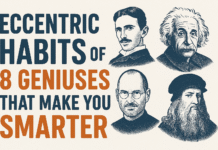|
Getting your Trinity Audio player ready...
|
Genius rarely arrives wearing a tidy suit and holding a neat schedule. It often slips in through the back door, disguised as a strange ritual, an unusual preference, or a habit that makes the rest of the world raise its eyebrows. If you look closely, history’s brightest minds often lived in ways that seemed odd at first glance, but these quirks were more than personal idiosyncrasies—they were hidden engines for creativity and problem-solving.
Albert Einstein, for instance, loved to wander aimlessly for hours. Neighbors would see him strolling with his hair in wild disarray, seemingly without a destination. To him, walking was not a break from thinking; it was thinking. Each step loosened the knots in his mind, letting ideas float up unforced. This gentle meandering of thought has echoes in the life of Nikola Tesla, though Tesla’s focus was sharper, almost obsessive. He felt an inexplicable pull toward the number three—walking around a block exactly three times before entering a building, touching objects in sets of three. It was his way of creating order before chaos, a mental ritual that primed him for invention.
From numbers to flavors, Beethoven’s mornings were marked by a meticulous routine: precisely sixty coffee beans measured for his brew. It wasn’t just caffeine—it was the ritual of control, the satisfaction of precision, the symbolic act of starting the day exactly right. That sense of deliberate motion reminds me of Steve Jobs, who preferred to hold meetings on his feet, walking outdoors with colleagues. Away from desks and fluorescent lights, ideas moved as freely as the people, and conversations unfolded with the rhythm of footsteps.
Maya Angelou took the opposite route—stillness and seclusion. She would rent a small, bare hotel room, strip it of any luxury, and sit with nothing but a notebook and her thoughts. The absence of comfort pushed her deeper into her work, sharpening her focus like a blade. Leonardo da Vinci, too, cultivated a strange form of discipline. His notebooks were filled with mirrored handwriting, backward scrawls only legible in a mirror. It wasn’t a puzzle for others—it was a way to see the world from an angle no one else considered, training his mind to dance between logic and imagination.
Then there was Immanuel Kant, who lived his life with the precision of clockwork. His neighbors could set their watches by his afternoon walk. For him, the absence of small daily decisions preserved his mental energy for philosophy. And on the far end of the spectrum of structure stood Salvador Dalí, whose genius was nurtured in moments of almost-sleep. He would nap with a key in his hand, and just as he drifted into a dream state, the key would fall, clattering to the floor and waking him. In that fragile space between waking and dreaming, he captured visions that others could only glimpse and forget.
These habits may look like harmless eccentricities, but they hold a common truth: brilliance thrives in unexpected spaces. Whether it’s walking without aim, counting coffee beans, sleeping with a key, or writing backward, each of these geniuses carved out a private doorway into deeper thought. Perhaps genius isn’t always about what you know, but about how you live—how you invite your mind to play, wander, and explore, even in the most peculiar ways.

















